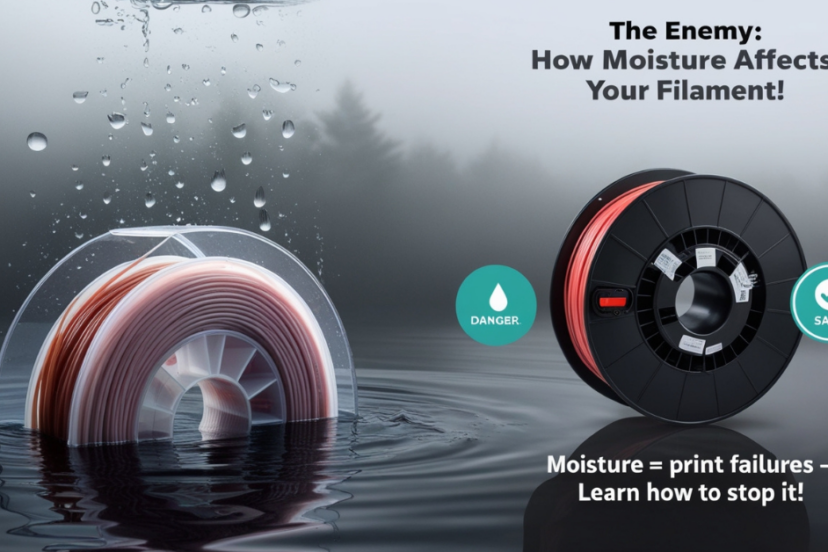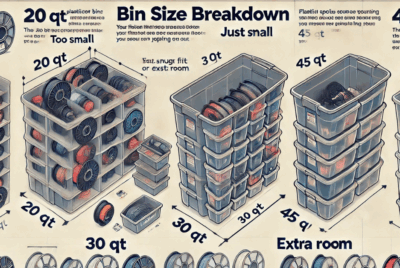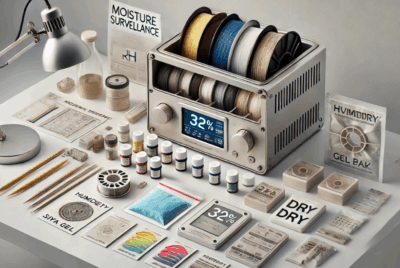What Are the Best Ways to Prevent Moisture in 3D Filament?
Preventing moisture from affecting your 3D filament is essential for ensuring high-quality prints. Filaments like Nylon, PETG, and others that are hygroscopic (absorb moisture from the air) can suffer from issues like bubbling, poor adhesion, and reduced print strength if exposed to moisture. Here are the best ways to prevent moisture in 3D filament:
1. Store Filament in Airtight Containers
- Why It Helps: Airtight containers prevent moisture from getting into the filament and keep it safe from humid environments.
- How to Do It:
- Use airtight plastic containers with tight-fitting lids or vacuum-sealed bags.
- For long-term storage, consider using vacuum-sealed bags with desiccants (moisture-absorbing packets) to keep the filament dry.
- Benefit: This is a simple, effective way to keep filament dry and ready for printing.
2. Use Desiccants
- Why It Helps: Desiccants, such as silica gel or clay desiccants, absorb moisture from the air, helping to keep the filament dry even in slightly humid environments.
- How to Do It:
- Place desiccant packets inside the storage container with your filament.
- Make sure to change or dry out the desiccants periodically as they can become saturated with moisture over time.
- Benefit: Desiccants are inexpensive and help maintain a moisture-free environment.
3. Use Filament Dry Boxes
- Why It Helps: Filament dry boxes are specifically designed to keep filament dry during both storage and printing. Many dry boxes have built-in desiccants and/or adjustable temperature control.
- How to Do It:
- Store your filament spools in a dry box with desiccant packets or a built-in heating element to control humidity.
- Benefit: Dry boxes provide a controlled, sealed environment that keeps filament dry during both storage and printing.
4. Store Filament in a Dry, Climate-Controlled Environment
- Why It Helps: Filament stored in areas with high humidity can absorb moisture, leading to printing problems. Storing filament in a dry, stable environment prevents this.
- How to Do It:
- Store your filament in a cool, dry area with humidity levels below 50%.
- Avoid storing filament in damp places like basements, kitchens, or bathrooms where moisture levels can fluctuate.
- Benefit: A stable, low-humidity environment reduces the risk of filament absorbing moisture.
5. Use Vacuum-Sealed Bags for Long-Term Storage
- Why It Helps: Vacuum-sealed bags remove air and prevent filament from absorbing moisture. This method is particularly effective for long-term filament storage.
- How to Do It:
- Place filament spools in vacuum-sealed bags with desiccant packets before sealing.
- Use a vacuum sealer to remove air and create a moisture-proof seal.
- Benefit: This is one of the most effective ways to prevent moisture and keep filament in excellent condition over long periods.
6. Use Filament Spool Holders with Humidity Control
- Why It Helps: Some filament spool holders are designed to help reduce the filament’s exposure to humidity while in use.
- How to Do It:
- Use a filament spool holder that includes built-in desiccant compartments or a controlled drying chamber.
- Benefit: These holders help prevent filament from absorbing moisture while it is in use and can be especially useful for long print jobs.
7. Dry Your Filament Before Printing
- Why It Helps: If filament has absorbed moisture during storage or handling, drying it before printing can restore its properties and prevent issues like bubbling or poor adhesion.
- How to Do It:
- Use a filament dryer, oven, or food dehydrator to dry the filament at a low temperature (around 45-50°C for PLA, 70-75°C for Nylon) for several hours.
- Always check the manufacturer’s recommendations for drying times and temperatures.
- Benefit: Drying filament before printing ensures that moisture won’t affect the quality of the print.
8. Store Filament in the Original Packaging
- Why It Helps: Many filament manufacturers pack their products in moisture-resistant bags with desiccant packs. Keeping the filament in its original packaging is an easy way to protect it from moisture.
- How to Do It:
- Store filament in its original vacuum-sealed bag with the included desiccants.
- If the original packaging is no longer available, transfer the filament to an airtight bag or container with new desiccant packets.
- Benefit: This method is quick and convenient, and it ensures that the filament is protected during storage.
9. Avoid Opening Filament Spools Unnecessarily
- Why It Helps: Each time you open a spool of filament, it is exposed to the surrounding air and moisture. By minimizing the number of times you open the spool, you reduce the filament’s exposure to humidity.
- How to Do It:
- Only open filament spools when you’re ready to use them.
- After use, reseal the spool in a vacuum-sealed bag or airtight container with desiccant.
- Benefit: Limiting exposure to air reduces the chances of filament absorbing moisture.
Summary
To prevent moisture in 3D filament, store it in airtight containers or vacuum-sealed bags with desiccants, keep it in a dry, climate-controlled environment, and use filament dry boxes for extra protection. Additionally, drying filament before printing, minimizing exposure to humidity, and using proper storage solutions like spool holders with humidity control can help keep your filament in optimal condition. These methods will ensure that your filament performs well, producing high-quality prints without issues caused by moisture.




